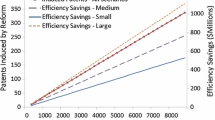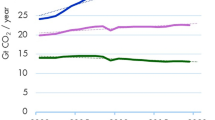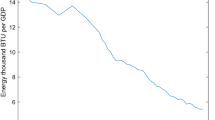Abstract
This paper addresses the objective of including Induced Technological Change (ITC) in research and policy models of energy, environment, and climate change. Theoretical foundations, fundamentals, and current methodologies for ITC models are reviewed. In addition, limitations and possible extensions to ITC models are explored. Current approaches to energy-environmental modeling that neglect technological characteristics such as heterogeneity, uncertainty, and path-dependence are likely to underestimate both the impact and the lags in the effectiveness of policy options.
Similar content being viewed by others
References
M. Abramovitz and P. David, Convergence and deferred catch-up: productivity leadership and the waning of american exceptionalism, in: Growth and Development: The Economics of the 21st Century, eds. R. Landua, T. Taylor and G. Wright (Stanford University Press, Stanford, CA, 1995) ch. 1.
K. Arrow, Economic welfare and the allocation of resources for invention, in: The Rate and Direction of Inventive Activity, NBER (Princeton University Press, Princeton, NJ, 1962).
B. Arthur, Competing technologies, increasing returns, and lock-in by historical small events, Economic Journal (March 1989).
R. Caballero and A. Jaffe, How high are the giants' shoulders: an empirical assessment of knowledge spillovers and creative destruction in a model of economic growth, NBER Macroeconomics Annual 8(8) (1993) 15–73.
C. Carraro, Induced technological change in environmental models: theoretical results and implementations, Working paper, Department of Economics, University of Venice; prepared for the IIASA Meeting on Induced Technical Change and the Environment, Laxenburg, Austria (1997).
U. Chakravorty, J. Roumasset and K. Tse, Endogenous substitution among energy resources and global warming, Journal of Political Economy 105(6) (1997).
T. Chapuis, M. Ha-Duong and M. Grubb, The Greenhouse cost model: an exploration of the implications for climate policy of inertia and adaptability in energy systems, Working paper, IIASA (June 1995).
H. Dowlatabadi and M. Oravetz, U.S. long-term energy intensity: backcast and projection, Working paper, Department of Engineering and Public Policy, Carnegie Mellon University (June 1997).
J. Fagerberg, Technology and international differences in growth rates, Journal of Economic Literature 32(3) (1994).
L. Goulder and K. Mathai, Optimal CO2 abatement in the presence of induced technological change, Working paper, Department of Economics, Stanford University (June 1997).
L. Goulder and S. Schneider, Induced technological change, crowding out, and the attractiveness of CO2 emissions abatement, Working paper, Department of Economics, Stanford University (October 1996).
Z. Griliches, The search for R&D spillovers, Scandinavian Journal of Economics 94 (1992) 29–47.
G.M. Grossman and E. Helpman, Innovation and Growth in the Global Economy (MIT Press, Cambridge, 1991).
G. Grossman and E. Helpman, Endogenous innovation in the theory of economic growth, Journal of Economic Perspectives 8(1) (1994).
M. Grubb, Technologies, energy systems, and the timing of CO2 emissions abatement: an overview of economic issues, in: Climate Change: Integrating Science, Economics, and Policy, IIASA Workshop Proceedings, eds. N. Nakicenovic, W. Nordhaus, R. Richels and F. Toth (1996).
M.J. Grubb, T. Chapuis and M. Ha-Duing, The economics of changing course: Implications of adaptability and inertia for optimal climate policy, Energy Policy 23(4/5) (1995).
M. Ha-Duong, M. Grubb and J.C. Hourcade, Optimal emission paths towards CO2 stabilisation and the cost of deferring abatement: the influence of inertia and uncertainty, Working paper, IIASA (May 1996).
Y. Hayami and V. Ruttan, Agricultural Development: An International Perspective, 2nd ed. (Johns Hopkins Press, 1985) chapters 4, 7.
C. Jones and J. Williams, Too much of a good thing: the economics of investment in R&D, Working paper, Department of Economics, Stanford University (1995).
D. Jorgenson, Technology in growth theory, in: Technology and Growth, Conference Proceedings, eds. J.C. Fuhrer and J.S. Little (Federal Reserve Bank of Boston, 1996) pp. 45–77.
D. Jorgenson and P. Wilcoxen, Energy, the environment and economic growth, in: Handbook of Natural Resources and Energy Economics, eds. A. Kneese and J. Sweeney (North-Holland, 1993) pp. 1267–1349.
J. Kim and L.J. Lau, The role of human capital in the economic growth of eat asian industrialized countries, Asia-Pacific Economic Review 1(3) (1995).
S. Kline and N. Rosenberg, An overview of innovation, in: The Positive Sum Strategy: Harnessing Technology for Economic Growth, eds. R. Landua and N. Rosenberg (National Academy Press, Washington, DC, 1986).
S. Messner, Endogenized technical learning in an energy systems model, Working paper, IIASA, Laxenburg, Austria (November 1995).
P. Mohnen, The econometric approach to R&D externalities, Cahiers de Recherche du Département des Sciences Economiques de l'UQAM, Cahier No. 9408, Université du Québec à Montréal (1994).
J. Mokyr, The Lever of Riches: Technological Creativity and Economic Progress (Oxford University Press, New York, 1990).
N. Nakicenovic, Technological change and learning, in: Climate Change: Integrating Science, Economics, and Policy, IIASA Workshop Proceedings, eds. N. Nakicenovic, W. Nordhaus, R. Richels and F. Toth (1996).
R.R. Nelson, Recent evolutionary theorizing about economic change, Journal of Economic Literature 33 (March 1995).
R.R. Nelson and S. Winter, An Evolutionary Theory of Economic Change (Harvard University Press, Cambridge, MA, 1982).
R. Newell, A. Jaffe and R. Stavins, Environmental policy and technological change: the effect of economic incentives and direct regulation on energy-saving innovation, Working paper, Harvard University, John F. Kennedy School of Government (10 December 1996).
W. Nordhaus, Managing the Global Commons: The Economics of Climate Change (MIT Press, Cambridge, MA, 1994).
W. Nordhaus, Modeling induced innovation in climate-change policy, Working paper, Department of Economics, Yale University (1997).
P. Romer, Endogenous technological change, Journal of Political Economy (1990).
P. Romer, The origins of endogenous growth, Journal of Economic Perspectives 8(1) (1994).
N. Rosenberg, Perspectives on Technology (Cambridge University Press, Cambridge, MA, 1976).
N. Rosenberg, Inside the Black Box: Technology and Economics (Cambridge University Press, Cambridge, MA, 1982) ch. 5.
N. Rosenberg, The impact of technological innovation: a historical view, in: The Positive Sum Strategy: Harnessing Technology for Economic Growth, eds. R. Landua and N. Rosenberg (National Academy Press, Washington, DC, 1986).
N. Rosenberg, Exploring the Black Box: Technology, Economics, and History (Cambridge University Press, Cambridge, MA, 1994).
V. Ruttan, Sources of technical change: induced innovation, evolutionary theory, and path dependence, Economic Development Center, Department of Economics, University of Minnesota (December 1996).
N. Sakurai, E. Ioannidis and G. Papaconstantinou, The impact of R&D and technology diffusion on productivity growth: evidence for 10 OECD countries in the 1970s and 1980s, OECD, Directorate for Science, Technology and Industry, STI Working paper No. 1996/2, Paris (1996).
J. Schmookler, Invention and Economic Growth (Harvard University Press, Cambridge, MA, 1966).
J. Schumpeter, Business Cycles, Vol. 1 (McGraw-Hill, New York, 1939) pp. 98–99.
R. Tol, The optimal timing of greenhouse gas emission abatement, the individual rationality and intergenerational equity, Working paper, Institute for Environmental Studies, Vrije Universiteit, Amsterdam (April 1996).
J. Weyant, Technological change and climate policy modeling, Working paper, Department of Engineering-Economic Systems and Operations Research, Stanford University; prepared for the IIASA Meeting on Induced Technical Change and the Environment, Laxenburg, Austria (1997).
T. Wigley, R. Richels and J. Edmonds, Economic and environmental choices in the stabilization of atmospheric CO2 concentrations, Nature 379(6582) (1996).
Author information
Authors and Affiliations
Rights and permissions
About this article
Cite this article
Weyant, J.P., Olavson, T. Issues in modeling induced technological change in energy, environmental, and climate policy. Environmental Modeling & Assessment 4, 67–85 (1999). https://doi.org/10.1023/A:1019012317160
Issue Date:
DOI: https://doi.org/10.1023/A:1019012317160




